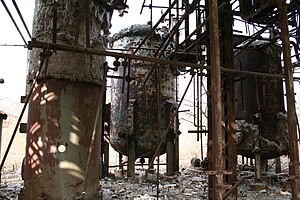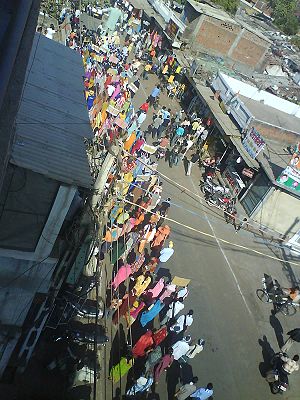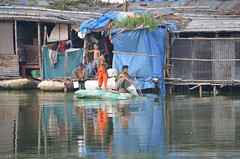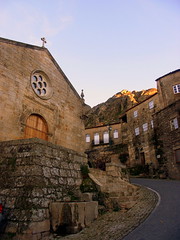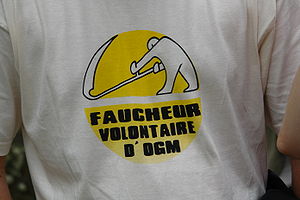 |
| T-shirt against GMO food. The logo is not copyrighted. (Photo credit: Wikipedia) |
Concordia University has started again its laudable Cinema Politica
series, and its third offering of this tenth year on Monday evening
featured a French film called Tous Cobayes?, or, in English, All of Us Guinea-Pigs Now?
This film, made by Jean-Paul Jaud last year, is a
root-and-branch attack on the whole idea of Genetically Modified Organisms (or
GMO) when applied to the growing of food.
This is still an extremely controversial subject, and the man
whose work this film is built on, Prof. Gilles-Eric Seralini, of Caen
University in France, is probably the most controversial figure in the global
movement around this subject.
In fact, the global application of GMO to the growing of food
crops is one of those subjects that arouses knee-jerk responses among most
people who have any interest in it. The
major company responsible for development of the genetic modifications
involved, Monsanto, has become a swear word among a certain section of the
population, and it is hardly possible any longer to take a moderate position as
between being pro-Monsanto and anti-Monsanto.
The fact is that Monsanto and the other companies involved seem
to be overwhelmingly winning the day in this battle: GMO food is being grown
throughout the world, with effects on people’s health, and the health of
society in general, that are at the centre of the argument.
Prof Seralini, a
microbiologist, has conducted a number of experimeNts on rats that were fed
corn genetically modified to be resistent to pesticides, because, they have
been manipulated to actually contain the pesticide within their physical structure. His results, when
published, have been roundly criticized by many scientists and major scientific
bodies, just as they have been supported by others. He has claimed that these
GMO foods have been allowed into circulation without being subject to adequate
testing to indicate their effects. The main argument he has used is that the
90-day trials normally undertaken by the companies have not been long enough to
give any worthwhie result. So last night’s film was about a long-term, two-year
study he conducted on a large number of rats which, as was shown in the film,
developed major, deforming tumours as a result of the food they were fed. He
compared them against a control group, in the approved manner, but there were
things about the way his study was finally released to the public that aroused
the ire of some scientists, and his methodology was also criticized.
Of course, from the point of view of a layman like myself
(and most other people) this is complicated by the power of the companies,
industries and governments that stand behind this GMO science. These are the wealth-owners
who, in effect, control most governments throughout the capitalist world, and
the suspicion is that many --- some would say, most --- of the scientists who
agree with GMO science are in some way controlled by, bought by or dominated by
the money forces that are profiting from it.
People are suspicious about things like that in these days, so it is
difficult for someone like myself, preternaturally suspicious as I am of the
corporate world, not to have a bias in favour of the brave people who are
opposing having this science forced on them in their everyday work and lives.
M. Jaud’s film makes no pretence at being objective or
even-handed: I had no objection to that because in my day I made films rather
like this one, and my rationale thirty years ago still pertains today, even
perhaps more so. In most cases --- certainly in these subjects under discussion
in this fim, GMO foods and nuclear power
---- the people one is fighting against are funded up to the hilt, have thousands
of employees including vast public relations departments whose very purpose is
to make the case for the corporate view of the world, and in such circumstances
why should a film-maker who has an hour in which to argue his case be expected
to provided twenty minutes or half an hour of his time to spokesmen for the
other side?
I didn’t object to that in the film, but, looking acak on it
I do feel that the film should have been produced by Cinema Politica with more
context for the guidance of its audience.
Most of what I have written about the widespread opinions criticizing
Prof. Seralini and all his works I have discovered from other sources: Cinema
Politica did not provide me with any suggestion that what we had been watching
was in any way a matter for dispute by reputable authorities, and I think they
should have done. (I have to add here, I left when the film finished: so far as
I could tell, no post-film discussion was intended, and if one took place after
I left what I have just said would no longer apply).
The second part of the film was an attack on nuclear power. With
this argument I wholeheartedly agreed. Much of what they showed dealt with the
victims of the nuclear meltdown at Fukushima, consequent on the disastrous
tsunami. The proponents of nuclear power always argue that it is safe, safer
than coal-fired or oil-powered electricity stations, for example. The
unfortunate fact is, however, that when an accident does occur, and there have
been several of them, it can have a disastrous impact on millions of people,
over a huge area of land. It can, in fact, poison land and make it unsafe for
habitation for decades to come. And not only that, but when the time comes to
decommission even a nuclear power station that has operated for years without accident, the real problem begins, which is that its
radio-active materials have to be guarded for thousands of years if they aren’t
to irrevocably damage tens of thousands of people.
Why any sane society would strike that Faustian bargain just
to get electricity, which can be generated by safer means, is beyond me. And M.
Jaud’s film makes that case so convincingly as to be beyond argument.
In the midst of the argument, The /guardian, always a reliable source, ran a blog saying that whatever the objections to M. /seralini, the issue cannot be swept under the carpet. /they outlined the half dozen or so masin objections to his research, along with his response:
My Log 382, October 8 2013
GMO foods, nuclear power, unfavoraby dissected in Cinema
Politica’s latest offering
Concordia University has started its laudable Cinema Politica
series, and its third offering of this tenth year on Monday evening
featured a French film called Tous Cobayes?, or, in English, All of Us Guinea-Pigs Now?
This film, made by Jean-Paul Jaud last year, is a
root-and-branch attack on the whole idea of Genetically Modified Organisms (or
GMO) when applied to the growing of food.
This is still an extremely controversial subject, and the man
whose work this film is built on, Prof. Gilles-Eric Seralini, of Caen
University in France, is probably the most controversial figure in the global
movement around this subject.
In fact, the global application of GMO to the growing of food
crops is one of those subjects that arouses knee-jerk responses among most
people who have any interest in it. The
major company responsible for development of the genetic modifications
involved, Monsanto, has become a swear word among a certain section of the
population, and it is hardly possible any longer to take a moderate position as
between being pro-Monsanto and anti-Monsanto.
The fact is that Monsanto and the other companies involved seem
to be overwhelmingly winning the day in this battle: GMO food is being grown
throughout the world, with effects on people’s health, and the health of
society in general, that are at the centre of the argument.
Prof Seralini, a
microbiologist, has conducted a number of experimeNts on rats that were fed
corn genetically modified to be resistent to pesticides, because, they have
been manipulated to actually contain the pesticide within their physical structure. His results, when
published, have been roundly criticized by many scientists and major scientific
bodies, just as they have been supported by others. He has claimed that these
GMO foods have been allowed into circulation without being subject to adequate
testing to indicate their effects. The main argument he has used is that the
90-day trials normally undertaken by the companies have not been long enough to
give any worthwhie result. So last night’s film was about a long-term, two-year
study he conducted on a large number of rats which, as was shown in the film,
developed major, deforming tumours as a result of the food they were fed. He
compared them against a control group, in the approved manner, but there were
things about the way his study was finally released to the public that aroused
the ire of some scientists, and his methodology was also criticized.
Of course, from the point of view of a layman like myself
(and most other people) this is complicated by the power of the companies,
industries and governments that stand behind this GMO science. These are the
wealth-owners who, in effect, control most governments throughout the
capitalist world, and the suspicion is that many --- some would say, most ---
of the scientists who agree with GMO science are in some way controlled by,
bought by or dominated by the money forces that are profiting from it. People are suspicious about things like that
in these days, so it is difficult for someone like myself, preternaturally
suspicious as I am of the corporate world, not to have a bias in favour of the
brave people who are opposing having this science forced on them in their
everyday work and lives.
M. Jaud’s film makes no pretence at being objective or
even-handed: I had no objection to that because in my day I made films rather
like this one, and my rationale thirty years ago still pertains today, even
perhaps more so. In most cases --- certainly in these subjects under discussion
in this fim, GMO foods and nuclear power
---- the people one is fighting against are funded up to the hilt, have
thousands of employees including vast public relations departments whose very
purpose is to make the case for the corporate view of the world, and in such
circumstances why should a film-maker who has an hour in which to argue his
case be expected to provided twenty minutes or half an hour of his time to
spokesmen for the other side?
I didn’t object to that in the film, but, looking acak on it
I do feel that the film should have been produced by Cinema Politica with more
context for the guidance of its audience.
Most of what I have written about the widespread opinions criticizing
Prof. Seralini and all his works I have discovered from other sources: Cinema
Politica did not provide me with any suggestion that what we had been watching
was in any way a matter for dispute by reputable authorities, and I think they
should have done. (I have to add here, I left when the film finished: so far as
I could tell, no post-film discussion was intended, and if one took place after
I left what I have just said would no longer apply).
The second part of the film was an attack on nuclear power.
With this argument I wholeheartedly agreed. Much of what they showed dealt with
the victims of the nuclear meltdown at Fukushima, consequent on the disastrous
tsunami. The proponents of nuclear power always argue that it is safe, safer
than coal-fired or oil-powered electricity stations, for example. The
unfortunate fact is, however, that when an accident does occur, and there have
been several of them, it can have a disastrous impact on millions of people,
over a huge area of land. It can, in fact, poison land and make it unsafe for
habitation for decades to come. And not only that, but when the time comes to
decommission even a nuclear power station that has operated for years without
accident, the real problem begins, which
is that its radio-active materials have to be guarded for thousands of years if
they aren’t to irrevocably damage tens of thousands of people.
Why any sane society would strike that Faustian bargain just
to get electricity, which can be generated by safer means, is beyond me. And M.
Jaud’s film makes that case so convincingly as to be beyond argument.
The British newspaper The Guardian, in a blog they published recently, asserted that the GMO issue cannot be swept under the carpet. They provided a list of the major objections to Prof. Seralini's work, and his responses to them:
1. The French researchers were accused of using the Sprague
Dawley rat strain which is said to be prone to developing cancers. In response
Séralini and his team say these are the same rats
as used by Monsanto in the 90-day trials which it used to get authorisation for its
maize. This strain of rat has been used in most animal feeding trials to
evaluate the safety of GM foods, and their results have long been used by the
biotech industry to secure approval to market GM products.
2. The sample size of rats was
said to be too small. Séralini responded that six is the OECD recommended
protocol for GM food safety toxicology studies and he had based his study on
the toxicity part of OECD protocol no. 453. This states that for a cancer trial
you need a minimum of 50 animals of each sex per test group but for a toxicity
trial a minimum of 10 per sex suffices. Monsanto used 20 rats of each sex per
group in its feeding trials but only analysed 10, the same number as Séralini.
3. No data was given about the
rats' food intake. Seralini says the rats were allowed to eat as much food as
they liked.
4. Séralini has not released the
raw data from the trial. In response he says he won't release it until the data
underpinning Monsanto's authorisation of NK603 in Europe is also made public.
5. His funding was provided by an
anti-biotechnology organisation whose scientific board Séralini heads. But he
counters that almost all GM research is funded by corporates or by pro-biotech
institutio








